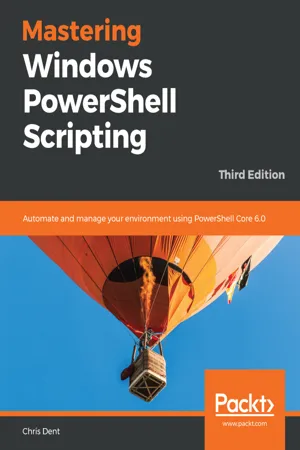
Mastering Windows PowerShell Scripting
Automate and manage your environment using PowerShell Core 6.0, 3rd Edition
Chris Dent
- 626 pages
- English
- ePUB (adapté aux mobiles)
- Disponible sur iOS et Android
Mastering Windows PowerShell Scripting
Automate and manage your environment using PowerShell Core 6.0, 3rd Edition
Chris Dent
À propos de ce livre
Grasp advanced PowerShell Core 6.0 functionalities to automate your environment
Key Features
- Keep up with changes introduced in PowerShell Core 6.0
- Easily maintain appropriate compatibility with older versions
- Automate complex tasks, manipulate data, and secure your environment with PowerShell Core 6.0
Book Description
PowerShell scripts offer a handy way to automate various chores, however working effectively with these scripts can be a difficult task.This comprehensive guide starts with the fundamentals before moving on to advanced-level topics to help you become a PowerShell Core 6.0 expert. The first module, PowerShell Core 6.0 Fundamentals, begins with the new features of PowerShell Core 6.0, installing it on Linux, and working with parameters, objects and.NET classes from within PowerShell Core 6.0. As you make your way through the chapters, you'll see how to efficiently manage large amounts of data and interact with other services using PowerShell Core 6.0. You'll be able to make the most of PowerShell Core 6.0's powerful automation feature, where you will have different methods available to parse data and manipulate regular expressions and Windows Management Instrumentation (WMI). After having explored automation, you will enter the extending PowerShell Core 6.0 module, covering asynchronous processing and desired state configuration. In the last module, you will learn to extend PowerShell Core 6.0 using advanced scripts and filters, and also debug issues along with working on error handling techniques.By the end of this book, you will be an expert in scripting with PowerShell Core 6.0.
What you will learn
- Optimize code through the use of functions, switches, and looping structures
- Work with objects and operators to test and manipulate data
- Parse and manipulate different data types
- Create scripts and functions using PowerShell
- Use jobs, events, and popular public modules which assist with implementing multithreading
- Write.NET classes with ease within the PowerShell
- Create and implement regular expressions in PowerShell scripts
- Make use of advanced techniques to define and restrict the behavior of parameters
Who this book is for
If you are a system administrator who wants to become an expert in controlling and automating your Windows environment, then Mastering Windows PowerShell Scripting is for you. It is also ideal for those new to the PowerShell language.
]]>
Foire aux questions
Informations
Section 1: Exploring PowerShell Fundamentals
- Chapter 1, Introduction to PowerShell
- Chapter 2, Modules and Snap-ins
- Chapter 3, Working with Objects in PowerShell
- Chapter 4, Operators
Introduction to PowerShell
- Exploring PowerShell fundamentals
- Working with data
- Automating with PowerShell
- Extending PowerShell
- What is PowerShell?
- PowerShell editors
- Getting help
- Command naming
- Command discovery
- Parameters and parameter sets
- Introduction to providers
- Introduction to splatting
Technical requirements
- Windows PowerShell 5
- PowerShell Core 6.1
What is PowerShell?
PowerShell editors

Getting help
- Get-Help
- Save-Help
- Update-Help
Updatable help
A list of modules that support updatable help may be viewed by running the following command: Get-Module -ListAvailable | Where-Object HelpInfoURI -like *.
PS> Get-Help Out-Null
NAME
Out-Null
SYNTAX
Out-Null [-InputObject <psobject>] [<CommonParameters>]
ALIASES
None
REMARKS
Get-Help cannot find the Help files for this cmdlet on this computer.
It is displaying only partial help.
-- To download and i...